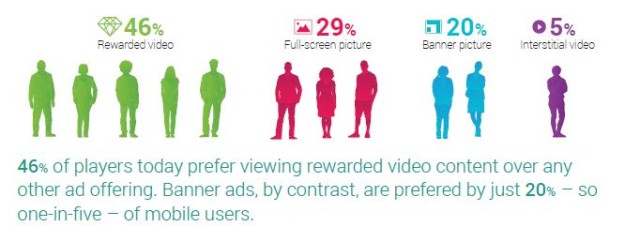If you’re wondering about the best way to utilize in-game ads in mobile games, you’re not alone. Finding the best and most efficient way to utilize in-game ads is vitally important to many mobile game developers, even to ones who don’t currently use any form of in-game advertising. That’s why this new report from Unity Technologies, In-Game Advertising the Right Way, is so important.
Over two thousand mobile developers and mobile game players were surveyed by Unity “to get a better understanding of their experience using ads.” The developers were eligible to provide data regardless of what development tools they used, and the players used a variety of mobile platforms.
Unity’s approach to the issue of in-game advertising is different than most because of the company’s business, which is primarily creating development tools such as Unity Engine, and assisting developers in using those tools. So Unity’s interest is in developer success, and figuring out which types of advertising are the most lucrative for developers is clearly to Unity’s advantage. At the same time, Unity also wants to identify any types of advertising that might affect developers in a negative way.
One of the first interesting things to know is that almost two-thirds of the developers surveyed have already used ads in their mobile games. “The reasons why so many choose to work with ads is a simple one to understand,” the report states. “A small share of players will actually pay using in-app purchases, placing a significant status on a tiny user-base to fund a game. In-game mobile ads, meanwhile, draw revenue even when players choose to spend nothing, never directly asking for cash, and without preventing those who choose to engage with IAP from spending in-game. The potential of ads to serve mobile games, then, is strikingly apparent, is important, and offers vast potential, not just to individual games, but to the longevity of the studios that make them.”
 On the player side, 71 percent of players watch in-game video ads, and 54 percent chose “rewarded” video specifically, as their preferred way to ‘pay’ for a mobile game. Compare that to 17 percent that liked interstitial video ads, 18 percent who preferred to pay upfront, and only 11 percent who preferred in-app purchases (IAP). That’s rather startling, since the assumption of many game designers (and marketers) is that in-app purchases are the more refined way of paying for a game, and one that should be preferred over advertising.
On the player side, 71 percent of players watch in-game video ads, and 54 percent chose “rewarded” video specifically, as their preferred way to ‘pay’ for a mobile game. Compare that to 17 percent that liked interstitial video ads, 18 percent who preferred to pay upfront, and only 11 percent who preferred in-app purchases (IAP). That’s rather startling, since the assumption of many game designers (and marketers) is that in-app purchases are the more refined way of paying for a game, and one that should be preferred over advertising.
This may perhaps be spillover from the success of some free-to-play PC games like League of Legends, where IAP is the only way the game monetizes, and the fans seem to love that method. That also seems to be true with other PC games such as World of Tanks, Hearthstone, and others, where you never see ads and don’t have to pay if you don’t want to, but many people do. Most mobile games have yet to reach this sort of engagement and user satisfaction with IAP, let alone the kind of revenue that these successful PC games achieve.
The games industry has learned a lot about getting mobile game ads right, and rewarded video ads are emerging as a powerful option for every kind of games maker. Overall, the message from this survey is clear: Video ads are the best form for mobile games, and more precisely rewarded video ads (where players get some sort of in-game benefit) are preferred by players.
“Rewarded video ads are the consumers’ first choice, and thus one that monetizes well, especially since many consumers view static interstitials as intrusive,” the report noted. “After all, happy players are staying players, and with rewarded video ads in mobile games higher retention means more viewed ads. That, in turn, boosts LTV and ARPU.”
Here’s some of the other key information from the report:
- 52 percent of mobile game developers surveyed identified video ads as providing the highest revenue per user compared to any other type of in-game advertising
- Almost 80 percent of players confirmed they are open to engaging with video ads for in-game rewards
- Less than 1-in-10 developers saw retention drop after introducing rewarded video ads
- 86 percent of developers who integrated rewarded video ads saw increased or unaffected in-app purchasing
- 58 percent of games makers are most likely to recommend rewarded video ads over any other in-game ad form to their game development peers
“Rewarded video ads are a key monetization and engagement method quickly growing in popularity with today’s mobile game developer community,” said Jarkko Rajamaki, director of ads for Unity Technologies. “When properly integrated into gameplay, video ads, especially rewarded video ads, have a positive impact on the player’s experience and can help developers monetize their games and increase player engagement.”
Another important finding is that ads do not reduce the desire to make in-app purchases. In fact, the data shows that ads increase IAP. While 14 percent of users spend less on IAP when there are ads in the game, 70 percent said it had no impact, and 16 percent said they spent more.
The use of in-game ads in mobile games should be seen as a very important source of revenue, and one that doesn’t necessarily cause problems with players if executed properly. Of course, there are plenty of other considerations to make in deciding when and how to use in-game ads, and a huge number of choices if you’re looking at various ad networks. The genre of game can also make a big difference to the perception and use of ads. Integrating ads into the game design along with rewards is an important issue for marketers and game designers to consider. Clumsy positioning of inappropriate ads can make a bad impression on players, and that’s not something any marketer wants.
Moreover, the demographics of the audience may be an important factor. Carefully examining similar games and their use of in-game advertising can provide some ideas of what to do and what to avoid.

